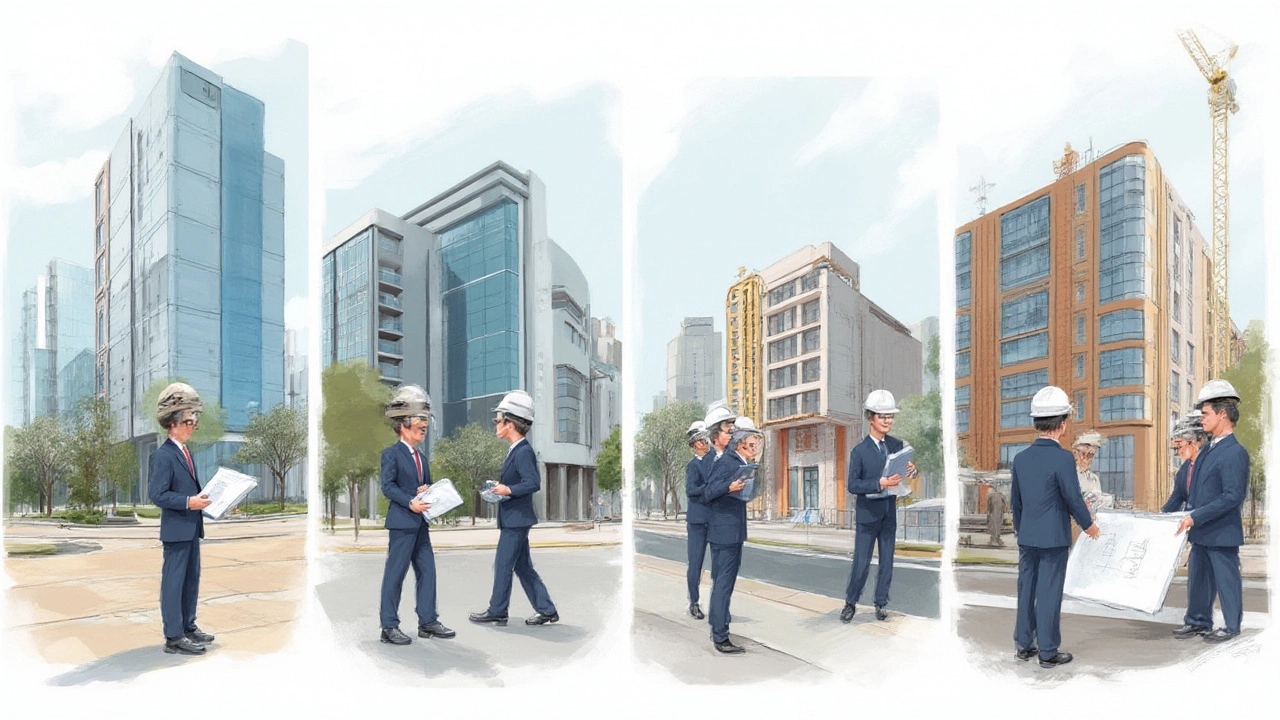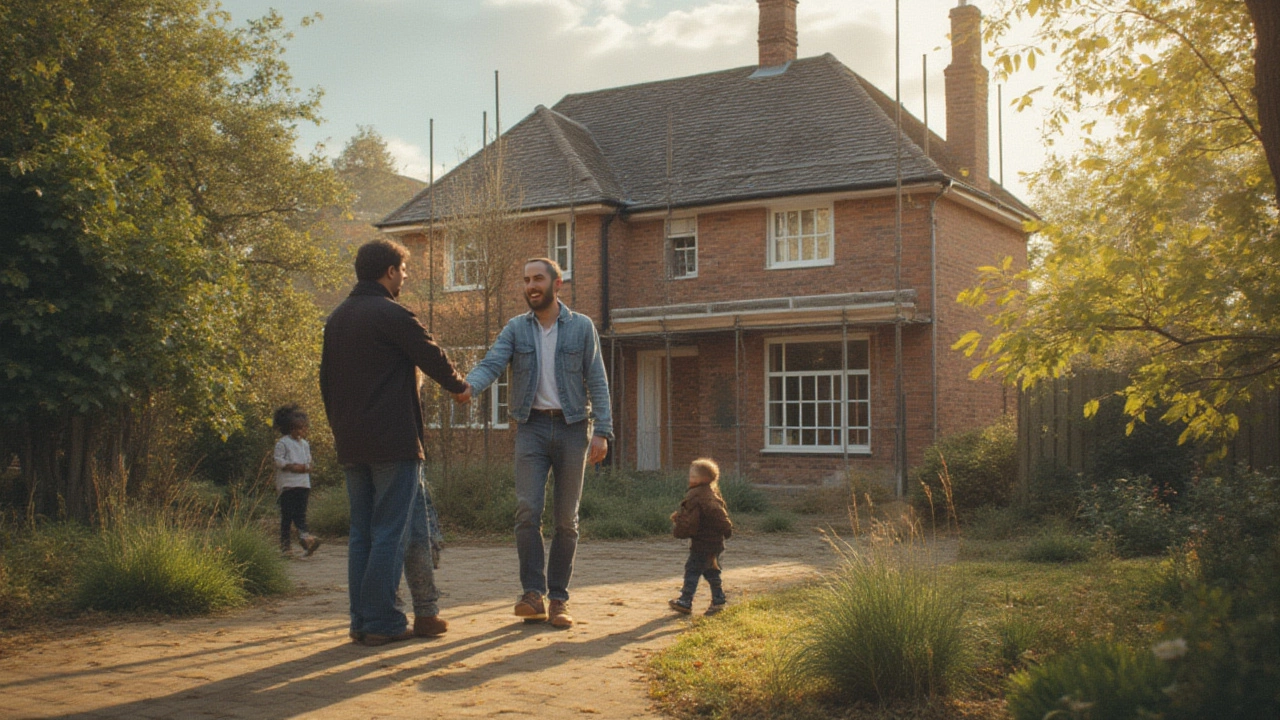Architectural Services Explained: Types, Process, and What Clients Should Know
 Aug, 1 2025
Aug, 1 2025
The thing about architecture is, it’s everywhere—shaping your city, your school, your neighborhood. But when you actually need an architect, figuring out what they really do can feel like untangling a ball of wires. Most people hear ‘architectural services’ and think just of blueprints or fancy computer models. That’s only a tiny slice of the pie. Architectural services cover a huge range, from the sketching of a single clever idea all the way to making sure the final building isn’t just a ticking code violation. If you’re planning to hire an architect, or you’re just curious about how professionals take a daydream and make it into an address, it’s time to look past the gloss and see how the whole process really works.
Main Types of Architectural Services
Not all architecture gigs are the same. Some people only want help with a porch addition; others need a ground-up hospital campus or a wildfire-proof eco-home. That means architectural services aren’t a one-size-fits-all deal. Let’s talk categories: there’s schematic design, design development, construction documents, construction administration, feasibility studies, site selection, interior architecture, master planning, and more.
The big one that almost always comes up first: design phases. Schematic design is about ideas—lots of options, wild sketches, and asking loads of ‘what if’ questions. Next is design development, which sharpens the details. Here, clients start seeing what the actual building will look and feel like—think materials, structure, mechanical systems, and code details. When things are set, architects create construction documents, and these are the ultra-precise blueprints used by contractors to build the project to spec.
But it doesn’t stop with drawings. Most people don’t realize architects also deal with permits, help choose contractors, answer questions from city officials or inspectors, and sometimes even help clients select doorknobs and lighting. Construction administration is a big deal: the architect watches over the build, checks the work, approves invoices, and solves problems before they get expensive. Some firms specialize in feasibility studies (will that wild rooftop addition even work on your tight lot, or will it collapse next winter?), or in early land planning, helping developers see potential pitfalls before they buy a property.
Table: Typical Architectural Services Offered
| Service | Purpose | When Used |
|---|---|---|
| Schematic Design | Concepts, sketches, options | Early project, exploring ideas |
| Design Development | Refining design, systems, materials | After ideas are chosen |
| Construction Documents | Detailed blueprints & specs | To guide construction |
| Construction Administration | Site visits, answering contractor's questions | During build |
| Feasibility Study | Checks if and how a project can happen | Before buying/building |
| Master Planning | Big-picture plans for large sites | For developments, campuses, complexes |
| Interior Architecture | Optimizing inside spaces | Commercial/residential, after exterior set |
If you walk into a big-name architecture firm, you’ll find even more: historic preservation (think restoring a 1920s train station to modern use), adaptive reuse (turning a brewery into apartments), sustainable design (solar, passive heating, carbon-conscious choices), or specialized commercial needs (like labs or medical centers with strict technical rules). Interior architecture is its own beast—the art and science of carving up interior space, making sure that offices, schools, homes, and stores actually work for real people. Every sector has its quirks. In the healthcare world, architects wrangle with layouts for privacy, safety, germ control, and tons of technical rules. Meanwhile, retail architects think about flow, signage, lighting, and how buildings nudge people to buy stuff. Whenever you see the phrase “full-service architecture,” think about a process that starts with sketches and ends only after the final punch list is signed off—sometimes years later.

The Step-by-Step Architecture Process
Here’s the breakdown: the way architects work isn’t just a flip of the sketchbook. You’re looking at a process sliced into bite-sized phases. Most architectural contracts follow the American Institute of Architects’ five main steps (lots of projects will add or drop phases, depending on needs): Pre-Design, Schematic Design, Design Development, Construction Documents, Construction Administration.
Pre-Design sometimes gets skipped, but it’s where the real homework happens. Architects might survey your site, research local codes, talk to city planners, and map out what’s allowed (and what isn’t). Sometimes they’ll even run zoning calculations or create a list of needs—how many bedrooms, parking spots, or square feet you want. Schematic Design is sketch city: bubble diagrams, loose plans, quick perspectives. This is where you get to see wild ideas that may surprise you. Don’t fall in love too soon though—lots will change in Design Development. That’s where drawings get real dimensions, windows switch sides, walls move, and mechanical engineers join the party to see where all the pipes and wires have to go.
Once the main idea is nailed down, construction documents follow. This is the grunt work: hundreds of sheets of drawings, notes, technical details, schedules for finishes and products. The building department will sift through these, so architects add code references, ADA requirements (for accessibility), energy-use data, and all the little footnotes that keep city inspectors happy. It’s a marathon, not a sprint. Many offices use advanced 3D modeling software—like Revit, Rhino, or ArchiCAD—to catch mistakes early, coordinate with engineers, and see how things fit in the real world.
Construction Administration is your safety net. Architects visit the site, snap progress photos, review the contractor’s questions (they’re called “RFIs”—requests for information), sort out changes, and review invoices and shop drawings. A good architect will catch problems the moment they pop up—maybe the framing is off, the windows arrive in the wrong size, or a new city regulation pops up mid-stream. Without this phase, clients can get blindsided by mistakes or go way over budget.
Tip for anyone working with an architect: keep communication steady and honest. The best projects happen when you’re clear about your needs, your budget, and your deal-breakers. Don’t assume your architect knows you want a sun-filled master bath—say it, write it down, and flag your priorities. If you’re worried about costs ballooning out of control, talk about value engineering early. That’s the process for swapping finishes or structural choices to save money without gutting the whole design.
Every phase comes with specific deliverables, and you can (and should) ask for copies of everything. If you’re renovating or working on a tight site, ask about digital modeling (BIM)—it’s not just for fancy skyscrapers anymore, and it can help you catch issues long before the concrete trucks roll up. The key difference between a solid project and an expensive headache is the way the process is managed from Day One.

Picking the Right Architectural Services for Your Project
No two jobs are identical. Your “perfect” architectural service plan depends on your budget, your timeline, the type of building, and—let’s face it—how much stress you can handle. If you’re just adding a backyard studio or redoing a kitchen, you might not need the full 5-phase package, but you do want a pro who understands codes, local conditions, and can catch tricky site issues before they bite. For a new commercial building or multi-unit development? You need the works: feasibility studies, master planning, and construction administration.
There’s a useful fact few clients are told: architectural fees are usually a percentage of the total build cost, running from about 5% for simple builds up to 15% (or more) for highly customized or tricky renovations. Some architects charge flat fees, others bill hourly for consulting services, especially for smaller tasks like interior finish selection or landscape reviews. For bigger jobs, you’ll want to see not just their design portfolio, but how well they steer projects through city approval, respond to contractor questions, and keep costs under control. Always ask for references, especially from people who’ve built something similar in your local market.
Here’s another tip: architects are legally on the hook for the buildings they design. If something goes wrong down the line (let’s say, a leaky roof or staircases that don’t meet code), the buck can stop at their door—so the smart ones are methodical, double-checking every detail. With all the digital tools available today, you can (and should) ask to see 3D walk-throughs, virtual plans, or models to spot any design features that might annoy you later. Don’t be shy—request a visual explanation of how your space is going to look, and ask about alternatives if it feels off.
Here’s a table from the National Council of Architectural Registration Boards (NCARB):
| Architectural Service | Most Common Use | Questions to Ask |
|---|---|---|
| Full Design & Construction Administration | Complex builds, large homes, commercial | Can you manage consultants, permitting, bidding? |
| Feasibility & Site Planning | Land acquisition, preliminary ideas | What site risks might I miss? |
| Interior Architecture Only | Office renovations, interiors, residential refreshes | Can you coordinate with furniture suppliers? |
| Permitting Only | Simple additions, minor renovations | What is required by the city/county? |
| Historic Preservation | Landmarks, old homes, adaptive reuse | Will I need special consultants or approvals? |
Eco-conscious? More architectural firms than ever now offer energy modeling, green roof design, LEED certification support, and passive house consulting—services well worth the investment if you want lower bills and a lighter environmental footprint.
If you’re on the fence about spending for full-service architecture, consider this: a good architect can often help you avoid far costlier problems during construction or later. Sloppy details or bad coordination can lead to piles of change orders, missed city inspections, or ugly surprises down the line. And for homebuyers, professional architectural drawings and oversight can become a selling point down the road, boosting value and buyer confidence.
So if you’re tired of vague promises, or just wondering how architects handle the journey from napkin sketch to move-in day, dig into the specifics. Get clear about which architectural services best suit your needs and don’t be afraid to ask questions—the right partnership can turn a pile of ideas into a place you’ll love for years to come.
